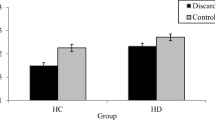Abstract
Pre- and posttreatment data from a treatment study utilizing Bandura's 18-item behavioral approach test (BAT)for fear of snakes were analyzed to assess the scalability of behavior and self-efficacy scores. Coefficients of reproducibility ranged from .97 to .99, indicating that measures of behavior and self-efficiacy on this BAT constitute valid Guttman scales. Bandura's (1980)method of calculating expected concordance rates is not valid for Guttman scales because all possible patterns of response produce observed concordance rates that are equal to or greater than expected rates it generates. The concordance rate between the items on Guttman scales are completely determined by the total score on each scale. Therefore, “microanalyses” of concordance rates between efficacy and behavior on BATs are redundant. Researchers using other dependent variable measures should determine the coefficients of reproducibility of their scales prior to reporting item-by-item concordance rates.
Similar content being viewed by others

Reference Notes
Kirsch, I., Tennen, H., Wickless, C., Saccone, A. J., & Cody, S.The role of expectancy in fear reduction. Unpublished manuscript, University of Connecticut, 1982.
Bandura, A. Personal communication, 1979.
References
Bandura, A. Self-efficacy: Toward a unifying theory of behavioral change.Psychological Review 1977,84 191–215.
Bandura, A. Gauging the relationship between self-efficacy judgment and action.Cognitive Therapy and Research 1980,4 263–268.
Bandura, A., & Adams, N. E. Analysis of self-efficacy theory of behavioral change.Cognitive Therapy and Research 1977,1 287–310.
Kirsch, I. “Microanalytic” analyses of efficacy expectations as predictors of performance.Cognitive Therapy and Research 1980,4 259–262.
Nie, N. H., Bent, D. H., & Hull, C. H.Statistical package for the social sciences. New York: McGraw-Hill, 1970.
Author information
Authors and Affiliations
Additional information
The authors wish to thank David A. Kenny and an anonymous reviewer for their extremely helpful comments on an earlier draft of this article.
Rights and permissions
About this article
Cite this article
Kirsch, I., Wickless, C.V. Concordance rates between self-efficacy and approach behavior are redundant. Cogn Ther Res 7, 179–188 (1983). https://doi.org/10.1007/BF01190071
Issue Date:
DOI: https://doi.org/10.1007/BF01190071



